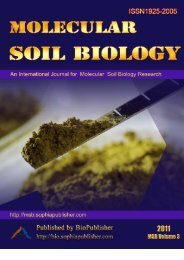Genomics and Applied Biology, 2010, Vol. 1 - Sophia Publishing ...
Genomics and Applied Biology, 2010, Vol. 1 - Sophia Publishing ...
Genomics and Applied Biology, 2010, Vol. 1 - Sophia Publishing ...
- No tags were found...
Create successful ePaper yourself
Turn your PDF publications into a flip-book with our unique Google optimized e-Paper software.
<strong>Genomics</strong> <strong>and</strong> <strong>Applied</strong> <strong>Biology</strong>, <strong>2010</strong>, <strong>Vol</strong>.1 No.2http://gab.sophiapublisher.comFigure 4 Neighbor-joining tree based on the deduced aminoacid sequences of HD homologsNote: Sequences were shown by their accession numbers (locustags) <strong>and</strong> strain names; Bootstrap values from neighbor-joininganalyses were listed to the left of each node, with values morethan 50 were shownFigure 7 Expression analysis of AhKR, AhHD <strong>and</strong> AhENRgenes in four different tissuesFigure 6 Neighbor-joining tree based on the deduced aminoacid sequences of ENR homologsNote: Sequences were shown by their accession numbers (locustags) <strong>and</strong> strain names; Bootstrap values from neighbor-joininganalyses were listed to the left of each node, with values morethan 50 were shown2 DiscussionPeanut is an important crop internationally for bothfood <strong>and</strong> oil production (Luo et al., 2005). One of themajor factors influencing peanut oil quality is thecomposition of fatty acid. So validating themechanism of the fatty acid synthesis <strong>and</strong> metabolismis the central goal to increase peanut quality. Fattyacid biosynthesis in higher plants is carried out bytype II FAS. In the present study, we isolated AhKR,AhHD <strong>and</strong> AhENR orthologues in peanut seedling.Sequence comparisons revealed that the primarystructure of plant plastid type II FAS enzymes (KR,HD, ENR) was strictly conserved, especially thecatalytic residues, which suggested that these enzymesmay have similar functions in higher plants as those inE. coli. Real-time RT-PCR analysis revealed that thethree genes were expressed dominantly in leaf amongfour tissues tested, <strong>and</strong> expressed at the lowest level instem. AhKR <strong>and</strong> AhENR genes shared similarexpression behaviors over the developmental stagescompared to that of AhHD gene. These results indicated- 17 -






